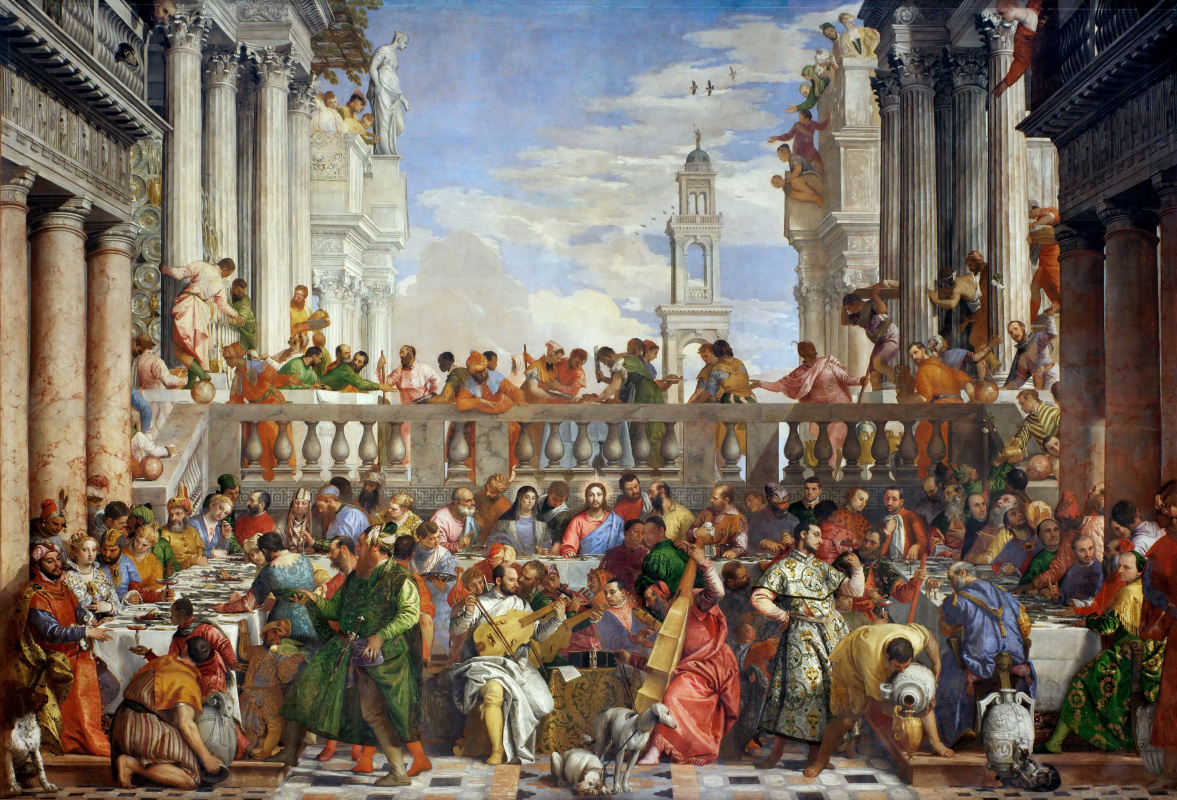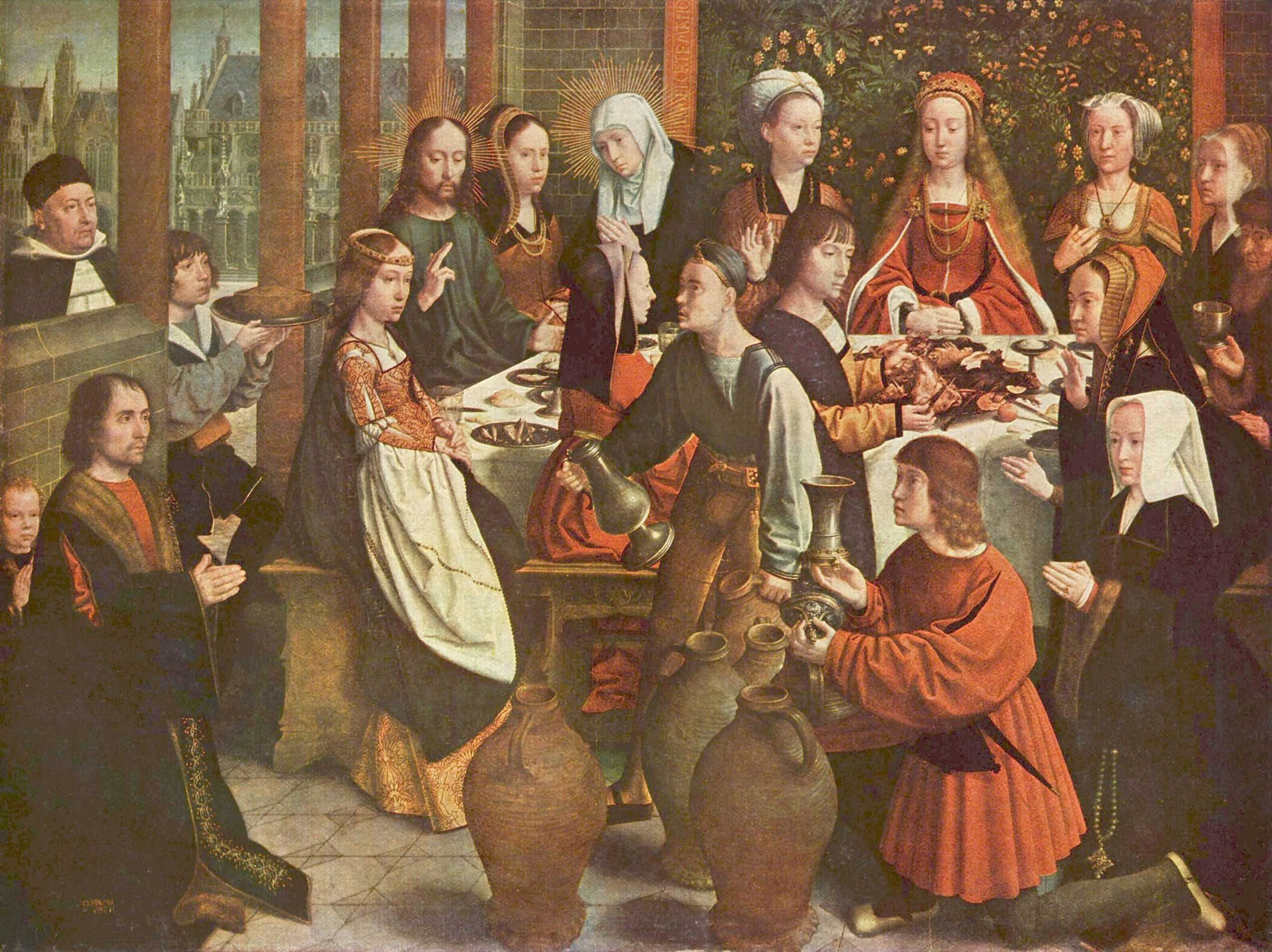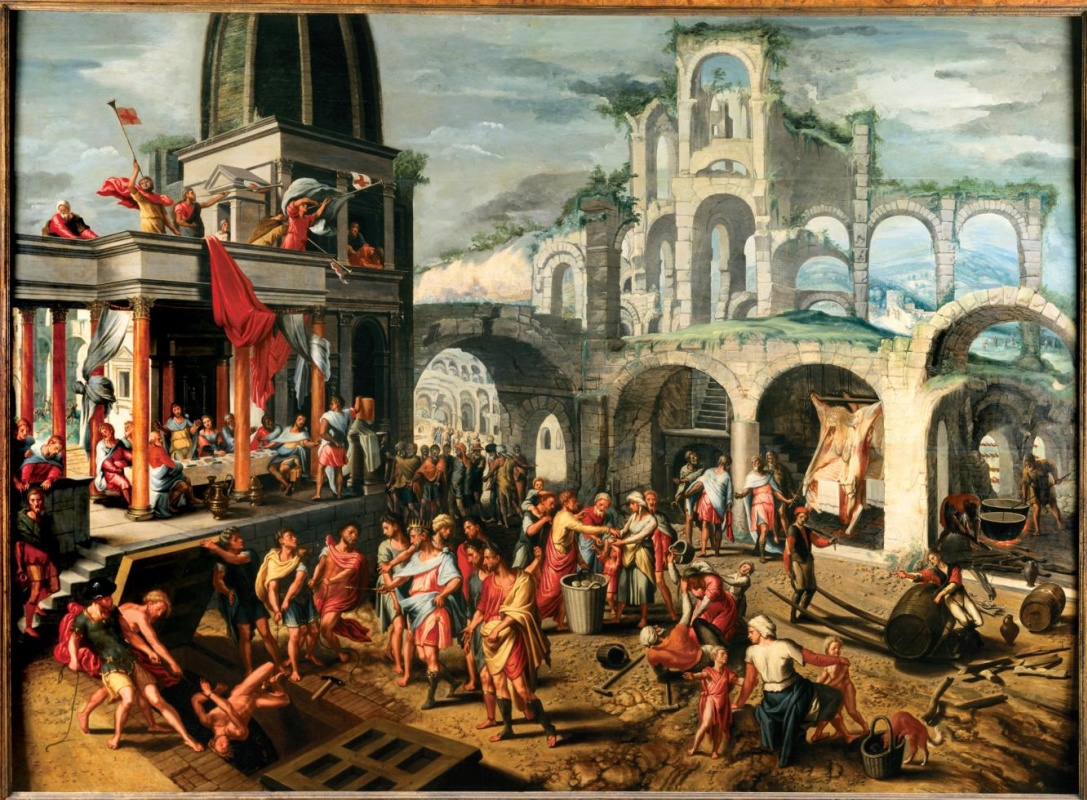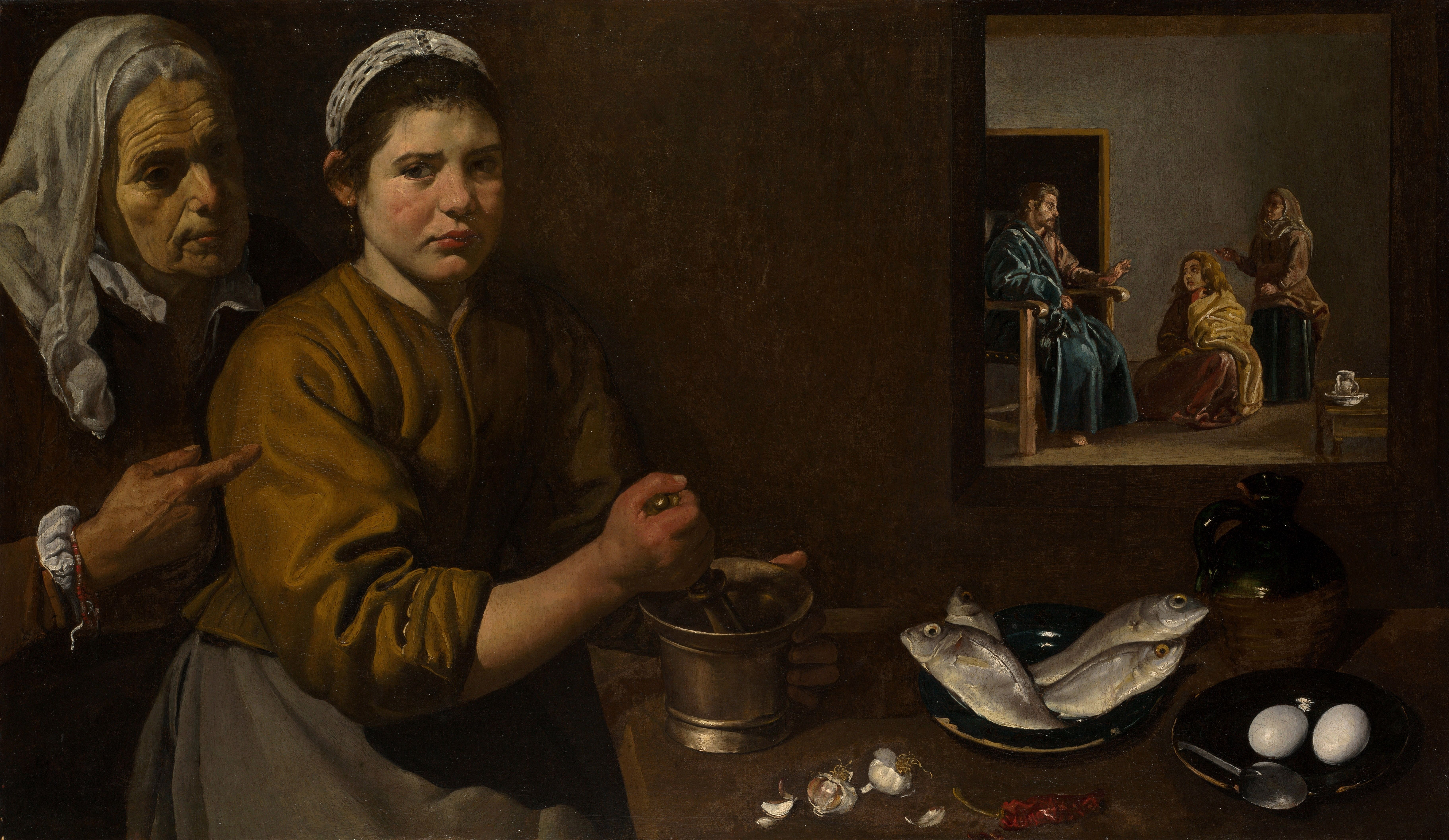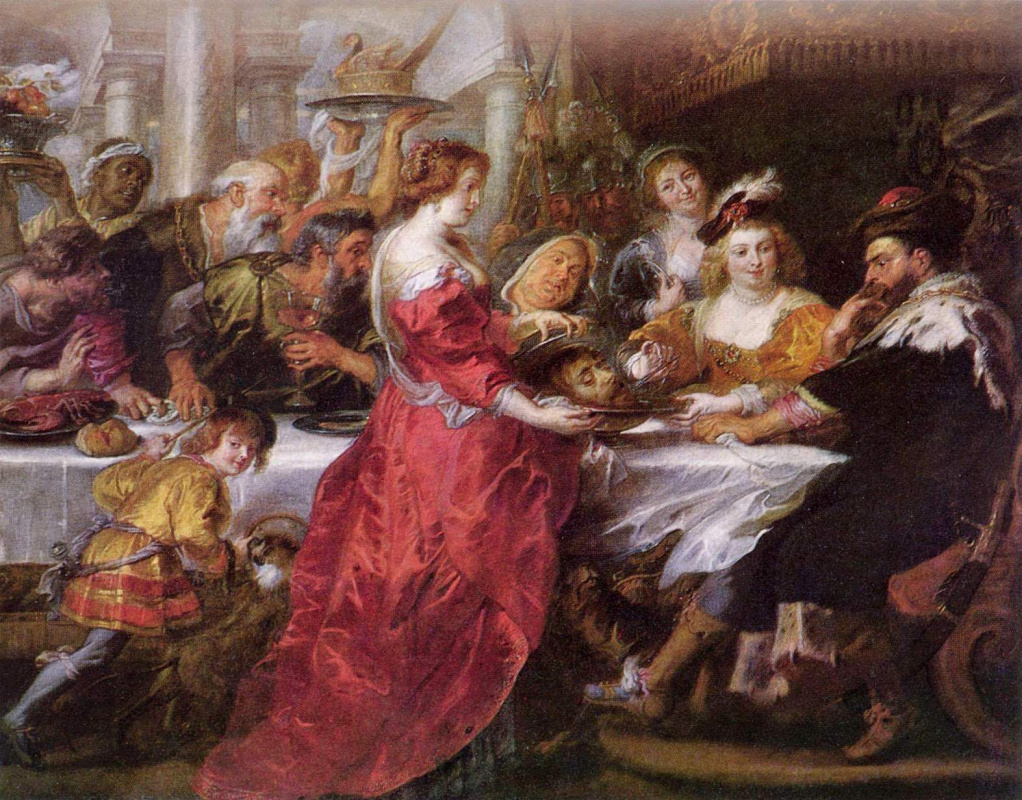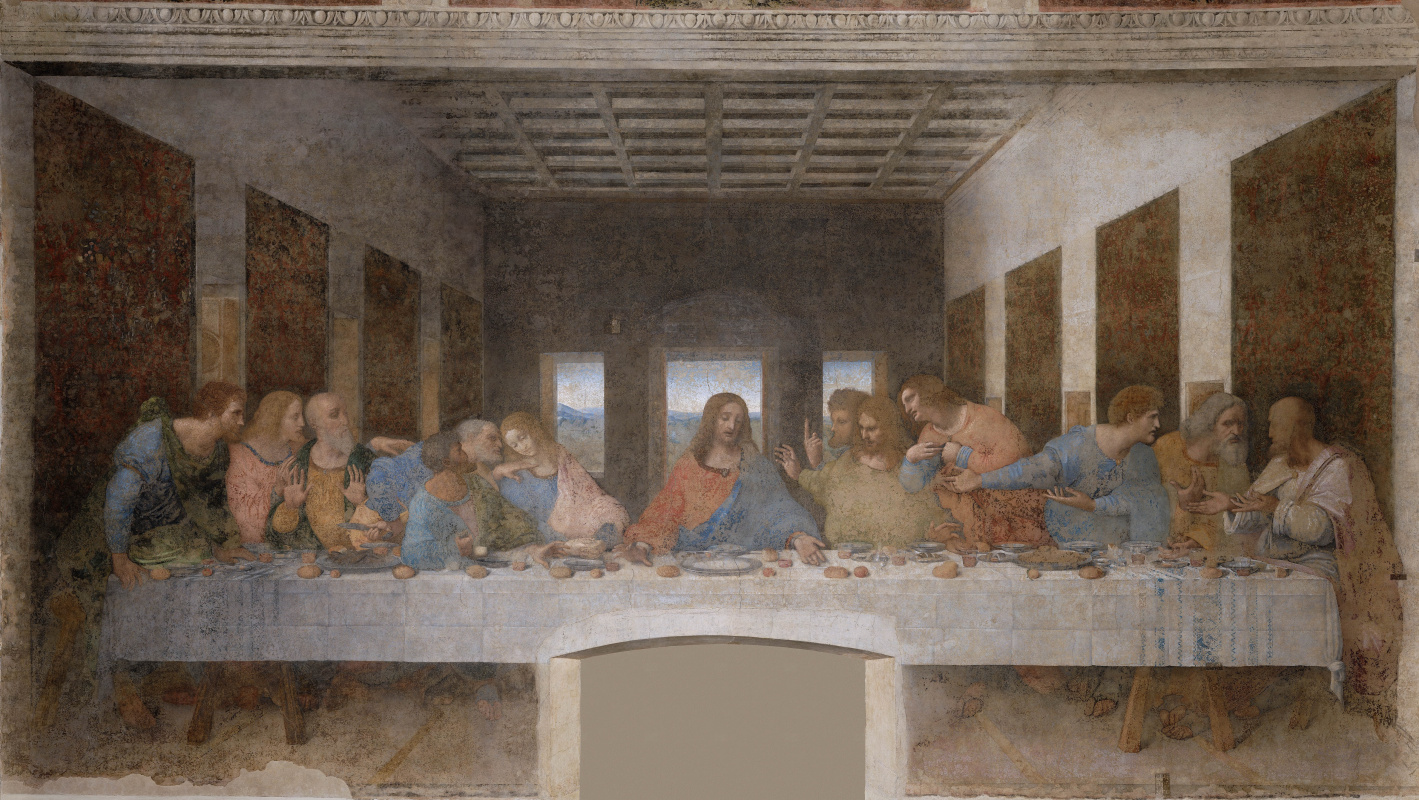How to celebrate so that no one loses his head on the go, is not confused by thoughts, does not get weak in his loins and does not lie down in an inappropriate manner? Concerning the epic New Year’s feasts ahead, it does not hurt to turn to the experience of biblical banquets.

Paolo Veronese. The Wedding Feast at Cana
Wedding in Cana of Galilee
1563, 667×994 cm
In 1562, the Venetian Benedictines commissioned Veronese to paint a picture for the refectory of the Abbey of San Giorgio Maggiore. Veronese created a grandiose canvas (its area is about 70 square meters), on which he placed about 130 figures. Among them are well-known contemporaries of Veronese (Roman Emperor Charles V, his implacable opponent King Francis I of France, Sultan of the Ottoman Empire
Suleiman the Magnificent and others). In the foreground, as musicians, Veronese portrayed himself, Titian, Tintoretto and Bassano — they are all dressed in the fashion of those years. Such a secular and free interpretation of the biblical subject did not arouse emotion in the Holy Inquisition: 10 years after the painting had been created, Veronese had to stand the trial on charges of heresy.
In 1798, the painting was taken to France by Napoleon, where it remains to this day, being the largest canvas in the Louvre.
What is all this?
The painting by Paolo Veronese depicts the subject that was described in the Gospel of John: "On the third day a wedding took place at Cana in Galilee. Jesus' mother was there, and Jesus and his disciples had also been invited to the wedding. When the wine was gone, Jesus' mother said to him, ‘They have no more wine.'"
At first, Jesus denied her. He replied that his hour had not yet come. But under pressure from his mother, he relented and showed the audience his first miracle — he turned water (according to various sources, from 500 to 720 liters) into wine, which, of course, pleased all the guests.
An important detail: unlike Bosch, Vermeer and many others who painted the Wedding at Cana, Veronese seated Jesus at the head of the table. There is a (relatively marginal) interpretation of the legend according to which Jesus was the groom at the wedding in Cana. For example, Gerard David seems to be an adherer of this version. However, Veronese had a different compositional accent: having seated Jesus in the centre, he only emphasized the main subject in this story.
In 1798, the painting was taken to France by Napoleon, where it remains to this day, being the largest canvas in the Louvre.
What is all this?
The painting by Paolo Veronese depicts the subject that was described in the Gospel of John: "On the third day a wedding took place at Cana in Galilee. Jesus' mother was there, and Jesus and his disciples had also been invited to the wedding. When the wine was gone, Jesus' mother said to him, ‘They have no more wine.'"
At first, Jesus denied her. He replied that his hour had not yet come. But under pressure from his mother, he relented and showed the audience his first miracle — he turned water (according to various sources, from 500 to 720 liters) into wine, which, of course, pleased all the guests.
An important detail: unlike Bosch, Vermeer and many others who painted the Wedding at Cana, Veronese seated Jesus at the head of the table. There is a (relatively marginal) interpretation of the legend according to which Jesus was the groom at the wedding in Cana. For example, Gerard David seems to be an adherer of this version. However, Veronese had a different compositional accent: having seated Jesus in the centre, he only emphasized the main subject in this story.
The marriage in Cana
1500, 128×96 cm
The moral
Theologians ascribe deep symbolism in this subject: the intercession of the Mother of God, the consecration of the sacrament of marriage, and even the transformation of water into wine, as the replacement of the Old Testament by the New. However, even without symbols and allegories, this is quite an instructive story. For example, the master of the banquet, having tasted the new wine, said to the groom: "Everyone brings out the choice wine first and then the cheaper wine after the guests have had too much to drink; but you have saved the best till now." It is worth listening — this is the millennial wisdom of the ancestors. And, of course, the main lesson that a responsible citizen must learn: don’t rest all the responsibility on the Saviour, who’d come and correct your mistakes, you have to do much yourself. And if you think 500 litres is enough, think again and take 720.
Theologians ascribe deep symbolism in this subject: the intercession of the Mother of God, the consecration of the sacrament of marriage, and even the transformation of water into wine, as the replacement of the Old Testament by the New. However, even without symbols and allegories, this is quite an instructive story. For example, the master of the banquet, having tasted the new wine, said to the groom: "Everyone brings out the choice wine first and then the cheaper wine after the guests have had too much to drink; but you have saved the best till now." It is worth listening — this is the millennial wisdom of the ancestors. And, of course, the main lesson that a responsible citizen must learn: don’t rest all the responsibility on the Saviour, who’d come and correct your mistakes, you have to do much yourself. And if you think 500 litres is enough, think again and take 720.
Pieter Aertsen. The Parable of the Marriage Feast
The parable of the wedding feast
1550-th
, 123×169 cm
Dutch artist Pieter Aertsen has become famous for his Gospel stories. Alas, many of his works were destroyed during the Bildenstorm (iconoclastic revolts that broke out in Flanders in 1566). This one was lucky to survive.
What is all this?
In the Gospel of Luke, the Kingdom of Heaven is likened to a wedding feast: "Jesus spoke to them again in parables, saying: ‘The Kingdom of Heaven is like a king who prepared a wedding banquet for his son. He sent his servants to those who had been invited to the banquet to tell them to come, but they refused to come. Then he sent some more servants and said, ‘Tell those who have been invited that I have prepared my dinner: My oxen and fattened cattle have been butchered, and everything is ready. Come to the wedding banquet." The invitees continued to turn up their noses — someone referred to urgent matters, someone suddenly fell ill, someone simply played coy — we have a bad line here in the lowlands, no one is at home, your call is very important for us, my secretary will certainly contact with you on Thursday… There were also those who insulted or even killed slaves. Then the king became angry, punished the murderers and burned their cities. Having sent the slaves to the street corners, he ordered them to invite everyone to the feast indiscriminately — thieves, beggars, demoniac, blind, ugly, anyone. This way, the wedding feast was filled with guests. "But when the king came in to see the guests, he noticed a man there who was not wearing wedding clothes. He asked, ‘How did you get in here without wedding clothes, friend?' The man was speechless. Then the king told the attendants, ‘Tie him hand and foot, and throw him outside, into the darkness, where there will be weeping and gnashing of teeth.' For many are invited, but few are chosen."
The moral
The imagery is understandable here: those who prefer worldly affairs to spiritual development will not get into the Kingdom of Heaven. And not only Jews. Anyone who appears at the afterparty without wearing the clothes of good manners will not pass the face control (which is why Aertsen and others portrayed the exile naked). There is another funny moral. Firstly, don’t neglect the dress code. And secondly, if you are invited to sit (or, for example, accumb) at a feast, do not get stubborn and asked too much.
In the Gospel of Luke, the Kingdom of Heaven is likened to a wedding feast: "Jesus spoke to them again in parables, saying: ‘The Kingdom of Heaven is like a king who prepared a wedding banquet for his son. He sent his servants to those who had been invited to the banquet to tell them to come, but they refused to come. Then he sent some more servants and said, ‘Tell those who have been invited that I have prepared my dinner: My oxen and fattened cattle have been butchered, and everything is ready. Come to the wedding banquet." The invitees continued to turn up their noses — someone referred to urgent matters, someone suddenly fell ill, someone simply played coy — we have a bad line here in the lowlands, no one is at home, your call is very important for us, my secretary will certainly contact with you on Thursday… There were also those who insulted or even killed slaves. Then the king became angry, punished the murderers and burned their cities. Having sent the slaves to the street corners, he ordered them to invite everyone to the feast indiscriminately — thieves, beggars, demoniac, blind, ugly, anyone. This way, the wedding feast was filled with guests. "But when the king came in to see the guests, he noticed a man there who was not wearing wedding clothes. He asked, ‘How did you get in here without wedding clothes, friend?' The man was speechless. Then the king told the attendants, ‘Tie him hand and foot, and throw him outside, into the darkness, where there will be weeping and gnashing of teeth.' For many are invited, but few are chosen."
The moral
The imagery is understandable here: those who prefer worldly affairs to spiritual development will not get into the Kingdom of Heaven. And not only Jews. Anyone who appears at the afterparty without wearing the clothes of good manners will not pass the face control (which is why Aertsen and others portrayed the exile naked). There is another funny moral. Firstly, don’t neglect the dress code. And secondly, if you are invited to sit (or, for example, accumb) at a feast, do not get stubborn and asked too much.
Diego Velázquez. Christ in the House of Martha and Mary
Christ in the house of Mary and Martha
1618, 60×103.5 cm
Some art critics believe that Velázquez borrowed the composition, in which food is in the foreground and the biblical subject is not, from the same Aertsen. One way or another, contemporaries perceived this work primarily as a genre scene. When in 1637 the owner of the painting, Fernando Afán de Ribera, Duke of Alcalá de los Gazules, died, in the census of his property the painting was listed as "The Girl Pounding Garlic".
What is all this?
The religious subject of this picture is a bit lost against the background of garlic, but therefore is no less important. One day Jesus stayed at the house of the sisters Martha and Mary. While Martha fussed about, serving the table, Mary sat at the feet of Christ and listened to him with bated breath. "She came to Him and asked, ‘Lord, don’t you care that my sister has left me to do the work by myself? Tell her to help me!' ‘Martha, Martha,' the Lord answered, ‘you are worried and upset about many things, but few things are needed — or indeed only one. Mary has chosen what is better, and it will not be taken away from her.'"
Medieval Western Christianity identified Mary of Bethany with Mary Magdalene and with the sinful woman who washed Jesus' feet, she is considered a repentant harlot.
In the Orthodox tradition, both sisters Martha and Mary are well-behaved girls, and there is no storyline with re-education.
The religious subject of this picture is a bit lost against the background of garlic, but therefore is no less important. One day Jesus stayed at the house of the sisters Martha and Mary. While Martha fussed about, serving the table, Mary sat at the feet of Christ and listened to him with bated breath. "She came to Him and asked, ‘Lord, don’t you care that my sister has left me to do the work by myself? Tell her to help me!' ‘Martha, Martha,' the Lord answered, ‘you are worried and upset about many things, but few things are needed — or indeed only one. Mary has chosen what is better, and it will not be taken away from her.'"
Medieval Western Christianity identified Mary of Bethany with Mary Magdalene and with the sinful woman who washed Jesus' feet, she is considered a repentant harlot.
In the Orthodox tradition, both sisters Martha and Mary are well-behaved girls, and there is no storyline with re-education.
Christ with Martha and Mary
1886, 191×303 cm
The moral
It is quite obvious. Choose the "good part". Kneel for a prayer more often and listen. Let someone else serve salads and go for champagne.
It is quite obvious. Choose the "good part". Kneel for a prayer more often and listen. Let someone else serve salads and go for champagne.
Peter Paul Rubens. The Feast of Herod
The Feast Of Herod
1640, 208×269 cm
It was not Rubens who came up with the idea of dressing the characters who lived in Galilee BC, according to the European fashion of the modern era — such are Herod’s guests on the canvases by Benozzo Gozzoli, Titian, Bartholomeus Strobel the Younger and many others. But the cover is an invention of Rubens. The painting on this subject was commissioned by the major Flemish collector Gaspar Roomer, who was extremely greedy for pictorial atrocities. Rubens knew how to please the customer. And he enhanced the dramatic effect: his Salome lifts the cover at the last moment, provoking curiosity and general agitation. The young lady, as though serves the head of the Forerunner to the table. The saint’s head, not the lobster, is the main dish of this cannibal revel.
What is all this?
Salome’s mother, Herodias was married to Herod Boeth, moreover, she had a relationship with her husband’s half-brother, the ruler of Galilee, Herod Antipas. John the Baptist publicly denounced this relationship.
Once at an Antipa’s birthday party, Salome danced for the hero of the occasion. Her dance was incendiary that Antipa promised to fulfil any of her whims as a reward. The girl asked for the head of the Forerunner.
Antipas was perplexed (even "grieved") by this demand, as he knew that John was a just and holy man. But he did not take back the word given in the presence of the guests: John the Baptist was beheaded.
Salome’s mother, Herodias was married to Herod Boeth, moreover, she had a relationship with her husband’s half-brother, the ruler of Galilee, Herod Antipas. John the Baptist publicly denounced this relationship.
Once at an Antipa’s birthday party, Salome danced for the hero of the occasion. Her dance was incendiary that Antipa promised to fulfil any of her whims as a reward. The girl asked for the head of the Forerunner.
Antipas was perplexed (even "grieved") by this demand, as he knew that John was a just and holy man. But he did not take back the word given in the presence of the guests: John the Baptist was beheaded.
The moral
No matter how famously the ladies you invited to the celebration dance, no matter what knyxens they perform, the price should be negotiated in advance. So that you don’t feel awkward in front of your friends, and no one has lost their heads.
No matter how famously the ladies you invited to the celebration dance, no matter what knyxens they perform, the price should be negotiated in advance. So that you don’t feel awkward in front of your friends, and no one has lost their heads.
Gerard van Honthorst. The Prodigal Son
The prodigal son
1623, 157×125 cm
Utrecht-born Gerard van Honthorst travelled extensively. When he was 20, he left for Rome (where he got his nickname Night Gerardo — the artist was especially successful at night scenes under artificial lighting), then lived and worked in London. On his return to Holland he settled in The Hague. He finally returned to his hometown when he was 62. In a sense, van Honthorst was the prodigal son himself. However, we do not know whether he spent his time in a foreign land as merrily as the hero of his painting.
What is all this?
In the Gospel of Luke, the parable of the prodigal son begins: "There was a man who had two sons. The younger one said to his father, ‘Father, give me my share of the estate.' So he divided his property between them. Not long after that, the younger son got together all he had, set off for a distant country and there squandered his wealth in wild living. After he had spent everything, there was a severe famine in that whole country, and he began to be in need."
Having suffered from need and hunger, the young man went to his father’s house to repent before his father and to be hired to serve him. Seeing his son, the old man threw himself on his neck and ordered the servants to bring "ring on his finger and sandals on his feet". He also ordered to stab the well-fed calf to make a feast and celebrate the son’s return.
The older son, who had meanwhile been working hard and led a righteous life, began to ask questions. But the father retorted: "‘My son, … you are always with me, and everything I have is yours. But we had to celebrate and be glad, because this brother of yours was dead and is alive again; he was lost and is found.'"
The moral
The essence of this life-affirming story lies in the all-forgiving nature of God, in his boundless love for both the righteous and sinners who have found the strength to repent. In other words, if you are a little lost at a corporate party — do not despair, but repent. And if your boss is a good shepherd, he will forgive and open his arms to you and pour more.
In the Gospel of Luke, the parable of the prodigal son begins: "There was a man who had two sons. The younger one said to his father, ‘Father, give me my share of the estate.' So he divided his property between them. Not long after that, the younger son got together all he had, set off for a distant country and there squandered his wealth in wild living. After he had spent everything, there was a severe famine in that whole country, and he began to be in need."
Having suffered from need and hunger, the young man went to his father’s house to repent before his father and to be hired to serve him. Seeing his son, the old man threw himself on his neck and ordered the servants to bring "ring on his finger and sandals on his feet". He also ordered to stab the well-fed calf to make a feast and celebrate the son’s return.
The older son, who had meanwhile been working hard and led a righteous life, began to ask questions. But the father retorted: "‘My son, … you are always with me, and everything I have is yours. But we had to celebrate and be glad, because this brother of yours was dead and is alive again; he was lost and is found.'"
The moral
The essence of this life-affirming story lies in the all-forgiving nature of God, in his boundless love for both the righteous and sinners who have found the strength to repent. In other words, if you are a little lost at a corporate party — do not despair, but repent. And if your boss is a good shepherd, he will forgive and open his arms to you and pour more.
Rembrandt Harmensz. van Rijn. Belshazzar’s Feast
The Feast Of Belshazzar
1638, 167.6×209.2 cm
Rembrandt is an obvious genius, and his painting is an outstanding masterpiece. However, this one differs from many other Belshazzar’s Feasts in details, which the artist approached with downright selfless pedantry. Rembrandt worked on the canvas for about two years, consulting with the rabbis of the Jewish community of Amsterdam about the details of clothing, dishes, gestures, beards and, of course, the mysterious inscription. The artist was advised to arrange the divine message in five columns and three lines by his friend and neighbour Menasseh ben Israel, a polyglot, philosopher, Torah scholar, a man of remarkable erudition. Thus, the inscription acquired the necessary mystery. Other artists arranged them traditionally — in one line, or even wrote in Latin.
What is all this?
The events of this Old Testament legend unfold in the 6th century BC. The ruler of Babylon, Belshazzar made an epic feast, disregarding the fact that the troops of the Persians were already at the walls of the city. In a fume of pride, Belshazzar ordered ritual dishes from the plundered Jerusalem temple to be put on the table. After the king and his Chaldeans tasted wine from the sacred dish, the hand of the Lord appeared and inscribed a message on the wall. Seeing this, Belshazzar’s "face turned pale and he was so frightened that his legs became weak and his knees were knocking." Some could think that all this (including the hand writing stange symbols on the walls) is a common thing if one tastes too much wine. But the inscription was seen by sober righteous people. Among them was the prophet Daniel, who managed to decipher the message: in short, God informed Belshazzar that he (and his kingdom) was up to the end. And so it happened — the Persians entered the city, Belshazzar was killed.
The moral
If you felt like the king of the world during a feast, temper your pride. There is no need to get the family crystal from the sideboard and pour drinks into cups from the grandmother’s service. Relics and shrines should be treated with respect — better stock up on disposable tableware.
The events of this Old Testament legend unfold in the 6th century BC. The ruler of Babylon, Belshazzar made an epic feast, disregarding the fact that the troops of the Persians were already at the walls of the city. In a fume of pride, Belshazzar ordered ritual dishes from the plundered Jerusalem temple to be put on the table. After the king and his Chaldeans tasted wine from the sacred dish, the hand of the Lord appeared and inscribed a message on the wall. Seeing this, Belshazzar’s "face turned pale and he was so frightened that his legs became weak and his knees were knocking." Some could think that all this (including the hand writing stange symbols on the walls) is a common thing if one tastes too much wine. But the inscription was seen by sober righteous people. Among them was the prophet Daniel, who managed to decipher the message: in short, God informed Belshazzar that he (and his kingdom) was up to the end. And so it happened — the Persians entered the city, Belshazzar was killed.
The moral
If you felt like the king of the world during a feast, temper your pride. There is no need to get the family crystal from the sideboard and pour drinks into cups from the grandmother’s service. Relics and shrines should be treated with respect — better stock up on disposable tableware.
Leonardo da Vinci. The Last Supper
The last supper
1498, 460×880 cm
The painting of the refectory in the Monastery of Santa Maria delle Grazie, which Leonardo created by order of his Milanese patron Ludovico Sforza, is shrouded by conspiracy theories, conflicting interpretations, anecdotes and legends. The most consistent one tells about the model for the figure of Judas. Leonardo had been looking for a suitable model for so long that the abbot of the monastery complained to Sforza about the artist’s laziness. In response, he threatened to paint Judas from the abbot, and the complaints immediately stopped. In the end, Leonardo found a drunkard with a suitable appearance on the street. Focusing his eye on the unfinished mural, the drunkard recalled that he had already been a model for this work. Three years ago (according to various sources, da Vinci painted The Last Supper for 3 to 7 years), when the model had not yet become a drunkard and was a singer in the church choir, Leonardo painted Christ from him.
What is all this?
Researchers are still debating exactly which moment of Ultima Cena — the Last Supper — did Leonardo da Vinci portray. Some believe that this is the establishment of the Sacrament of the Eucharist: the left hand of Christ seems to bless the bread — "Take, eat, this is My Body". Others are sure that Leonardo painted the prophecy about the betrayal of Judas: "He who has dipped his hand in the dish with me will betray me."
The moral
The "simple" conclusions that can be drawn from this instructive story can be as varied as the interpretation of Leonardo’s painting.
On the one hand, it can be understood as a warning: in the fervour of the supper, one would better think with whom he is breaking bread. On the other hand, it is quite a hopeful plot. No matter how dramatic the events of the festive banquet are, no matter how difficult its consequences are, everything will be fine in the end. You just need to keep hope and faith.
What is all this?
Researchers are still debating exactly which moment of Ultima Cena — the Last Supper — did Leonardo da Vinci portray. Some believe that this is the establishment of the Sacrament of the Eucharist: the left hand of Christ seems to bless the bread — "Take, eat, this is My Body". Others are sure that Leonardo painted the prophecy about the betrayal of Judas: "He who has dipped his hand in the dish with me will betray me."
The moral
The "simple" conclusions that can be drawn from this instructive story can be as varied as the interpretation of Leonardo’s painting.
On the one hand, it can be understood as a warning: in the fervour of the supper, one would better think with whom he is breaking bread. On the other hand, it is quite a hopeful plot. No matter how dramatic the events of the festive banquet are, no matter how difficult its consequences are, everything will be fine in the end. You just need to keep hope and faith.






